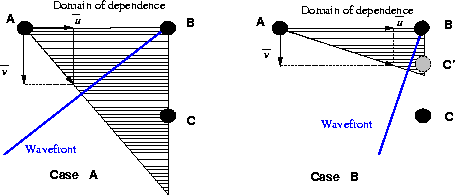




Next: THE ADAPTIVE STEP IMPLEMENTATION
Up: Popovici : Stability for
Previous: INTRODUCTION
The Courant-Friedrichs-Lewy (CFL) condition states that a necessary
condition for
the convergence of an explicit finite difference scheme is
that the domain of dependence of the
discrete problem
includes the domain of dependence of the differential equation in the limit
as the length of the finite difference steps goes to zero.
The CFL condition is easy to understand when examining the two cases in Figure 1.
In the first case, the plane wave propagates with an angle  given
by the arctangent of the two vectors
given
by the arctangent of the two vectors  .The explicit upwind finite difference stencil will use the traveltime
values in points A and B to calculate the value in point C.
When the plane wave propagates with an angle
.The explicit upwind finite difference stencil will use the traveltime
values in points A and B to calculate the value in point C.
When the plane wave propagates with an angle  as in the second
case, the information from points A and B is propagated to the right
and above point C. In this case the point C is outside the domain of
dependence and numerical instabilities can appear.
To ensure the stability of the algorithm I use an adaptive step
algorithm which will calculate the position of the point C' inside the
domain of dependence.
as in the second
case, the information from points A and B is propagated to the right
and above point C. In this case the point C is outside the domain of
dependence and numerical instabilities can appear.
To ensure the stability of the algorithm I use an adaptive step
algorithm which will calculate the position of the point C' inside the
domain of dependence.
stencil
Figure 1 Two cases in plane
wave propagation
for the explicit finite difference traveltime algorithm. a) The domain of
dependence includes the new stencil point. b) The domain of dependence
doesn't include the stencil point C, requiring an adaptive step at C'.






Next: THE ADAPTIVE STEP IMPLEMENTATION
Up: Popovici : Stability for
Previous: INTRODUCTION
Stanford Exploration Project
12/18/1997
![]() given
by the arctangent of the two vectors
given
by the arctangent of the two vectors ![]() .The explicit upwind finite difference stencil will use the traveltime
values in points A and B to calculate the value in point C.
When the plane wave propagates with an angle
.The explicit upwind finite difference stencil will use the traveltime
values in points A and B to calculate the value in point C.
When the plane wave propagates with an angle ![]() as in the second
case, the information from points A and B is propagated to the right
and above point C. In this case the point C is outside the domain of
dependence and numerical instabilities can appear.
To ensure the stability of the algorithm I use an adaptive step
algorithm which will calculate the position of the point C' inside the
domain of dependence.
as in the second
case, the information from points A and B is propagated to the right
and above point C. In this case the point C is outside the domain of
dependence and numerical instabilities can appear.
To ensure the stability of the algorithm I use an adaptive step
algorithm which will calculate the position of the point C' inside the
domain of dependence.
